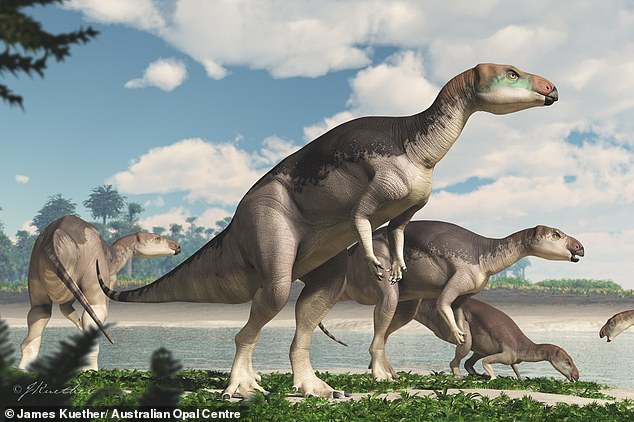This promised to be fascinating, a headline claiming a herd of dinosaurs had been discovered in an opal mine in New South Wales. Turns out it was four, two juveniles and two adults – a small family group. Go to https://archaeologynewsnetwork.com/2019/06/herd-of-dinosaurs-has-been-di… … and www.dailymail.co.uk/news/article-7101457/ … the paleontologists were stunned by the sheer number of bones found – presumably broken and jumbled. It is described as the first 'herd' of dinosaurs found in Australia (interpretation, a cache of more than one individual). It also represents a new kind of dinosaur – or a variation on other species. It has been named as Fostoria dhimbangunmal – after the name of the opal miner that found the cache, Robert Foster, rather than Fosters Lager Beer that he might have been drinking with his sandwiches. The term dhimbangunmal means 'shipyard' in the local dialect – the locality is known as Shipyard. The remains of four dinosaurs were found. Partial skeletons of extinct swimming reptiles have been found at other Australian opal fields. Fostoria on the other hand was a plant eating iguanadon.

Over at https://archaeologynewsnetwork.blogspot.com/2019/06/paleontologists-disc… … paleontologists have found the largest elasmosaurid so far, a Loch Ness look alike we are assured. This one comes from the islands between Argentina and Antarctica. It would have weighed over 12 tons and it seems they filled the dinosaur niche now occupied by whales. The elasmosaurids are part of the family of plesiosaurs which died out at the end of the Cretaceous. It is also part of a sub family of the plesiosaurs, the aristonectinos which had a shorter neck and a bigger skull. It is thought that rather than chomping like most plesiosaurs these reptile fish spread open their mouths and caught a large number of small prey, such s crustaceans. This type of capture is similar to modern whales (of the mammal era) who feed on plankton and krill. It seems evolution may have repeated itself.

We now have dinosaur bats and mammalian bats, dinosaur dolphines (ichthiosaurs) and mammalian dolphins, and now we have reptiles that feed like whales and mammalian whales. A fascinating windown on bioevolutionary change.
